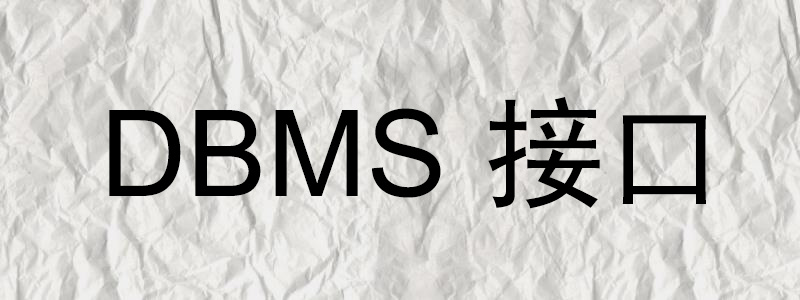
A database management system (DBMS) interface is a user interface that allows queries to be entered into a database without using a query language itself. The following article will introduce you to the DBMS interface. I hope it will be helpful to you.

# Query languages (such as SQL) are used in database management systems to store data and respond to queries. The DBMS interface provides a way to access and query data without using query language or command line, which makes querying simple and convenient. [Video tutorial recommendation: MySQL video tutorial]
The user-friendly interface provided by the DBMS may include the following:
1. Menu-based interfaces for web clients or browsing
These interfaces provide the user with a list of options (called a menu) that can guide the user to complete the request.
The basic advantage of using menus is that you can use them to complete the query step by step without manually writing any specific commands and syntax for the query language, by collecting or selecting options from the menus that are basically displayed on the system.
You can use drop-down menus in DBMS, which is a very popular technology in web-based interfaces. They are often used in browsing interfaces, allowing users to browse the contents of a database in an exploratory and unstructured way.
2. Form-based interface
The form-based interface displays a form to each user. Users can fill in all form entries to insert new data; they can also fill in only certain entries, in which case the DBMS will replace the other remaining entries with the same type of data.
This type of form is usually designed, created, and programmed for users who have no expertise in the operating system. Many DBMSs have form specification languages, which are special languages that help specify such forms.
3. Graphical User Interface
Graphical user interface usually displays the pattern to the user in the form of a chart, and the user can then specify the query by manipulating the chart. In many cases, GUIs can use both menus and forms; most GUIs use a pointing device such as a mouse to select parts of the displayed pattern diagram.
4. Natural Language Interface
These interfaces accept requests written in English or other languages and try to understand them. Natural language interfaces have their own schemas, similar to database conceptual schemas and dictionaries of important words.
Natural language interface refers to the words in its schema and a standard set of words in the dictionary used to interpret the request. If the interpretation is successful, the interface generates a high-level query corresponding to that natural language and submits it to the DBMS for processing, otherwise a dialogue with the user is initiated to clarify any provided conditions or requests.
5. Voice input and output
The use of voice is limited, such as it is used to query or answer questions, or as a result of a request, which makes it The vocabulary is limited and common.
Predefined words are required to detect speech input and are used to set the parameters provided to the query. For output, a similar conversion from text or numbers to speech occurs.
6. DBA interface
Most database systems contain privileged commands that can only be used by DBA employees. These commands include creating accounts, setting system parameters, granting account authorizations, changing the schema, and reorganizing the storage structure of the database.
The above is the entire content of this article, I hope it will be helpful to everyone's study. For more exciting content, you can pay attention to the relevant tutorial columns of the PHP Chinese website! ! !
The above is the detailed content of What is a DBMS interface? A brief discussion on DBMS interface. For more information, please follow other related articles on the PHP Chinese website!